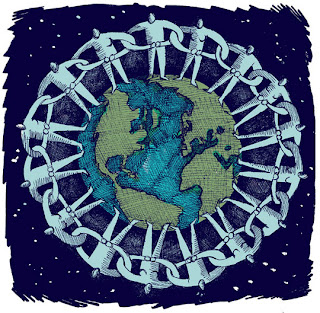LONDON – What
defines a modern human? The biological answer is simple: a member of the
species Homo sapiens that is characterized by such features as a
relatively large brain set in a globular braincase, small brow ridges over the
eyes, a small retracted face, a chin on the lower jaw, and a lightly built
skeleton. Many of modern humans’ biological traits – at least those that can be
preserved as fossils – were already present in Africa
and Israel more
than 100,000 years ago.
Given that humans’ morphological and behavioral characteristics evolved at different rates, this question is a source of controversy. Indeed, paleontologists studying the physical origins of Homo sapiens will inevitably differ from archaeologists reconstructing ancient behavior over what constitutes an early modern human.
Recent discoveries in paleontology, archaeology, and especially genetics of striking similarities between extant humans and some ancient populations are further complicating assessments of modern humans’ origins. One leading idea was that modern humans’ primitive ancestor Homo erectus left Africa nearly two million years ago, and dispersed into other areas of the world. Regional populations then steadily evolved into Homo sapiens, with modern human behaviors first emerging in Europe roughly 40,000 years ago.
But new evidence suggests that modern humans evolved relatively recently in Africa – and that the transformation that they underwent after their departure some 60,000 years ago was far from seamless. Specifically, studies of Homo sapiens’ close but extinct relatives, the Neanderthals, are revealing new facets of modern human development, while intensifying the long-running debate over the differences between the two species’ behavioral capabilities.
Growing archaeological evidence of key elements associated with Homo sapiens is emerging at sites in Africa that are more than 60,000 years old. These include complex tools (which require several stages of manufacture), symbolism (for example, red hematite pigments for notation and beads for display, made from sea shells and ostrich eggshells), and long-distance networks of contact and exchange. These discoveries support some archaeologists’ view that only Homo sapiens was advanced enough to be considered truly modern humans, while non-modern groups like the Neanderthals displayed, at best, only incipient signs of such complexity.
Moreover, genetic evidence, based on distinct DNA coding that is known to be related to brain functions in modern humans, suggests at least some cognitive contrasts between Neanderthals and Homo sapiens. And demographic differences (small, low-density populations) may have hindered Neanderthals’ cultural evolution, compared with the wider networks established by early modern human groups, initially in Africa, and subsequently worldwide.
But evidence also suggests that some Neanderthals buried their dead with grave goods (items presumably intended to help the deceased in the afterlife), produced complex tools (such as stone armatures mounted with mastics), and developed personal symbols (including manganese oxide pigments and pendants made from animal teeth). They apparently also used plants with medicinal properties.
Furthermore, increasingly sophisticated DNA studies of extinct populations have shown that, despite their general classification as the distinct species Homo neanderthalensis, Neanderthals interbred with modern human groups as they dispersed out of Africa. As a result, many people’s genomes contain roughly 1% Neanderthal DNA.
Given this hybridization, some researchers argue that the species boundary between modern humans and Neanderthals should be reconsidered, and that both should be classified as Homo sapiens. But I believe that a morphology-based species distinction is still warranted. In fact, the scientific dispute reflects the real-world limitations of the concept of distinct biological species, which does not allow for interbreeding.
The situation is further complicated by additional instances of ancient interbreeding among native populations in Africa and Australasia (for example, Australia, New Guinea, and Bougainville). In the latter case, the interbreeding derived from a population known so far from only one site – Denisova cave in southern Siberia. Fossils from there contain DNA related to, but distinct from, that of the Neanderthals.
Today, remnants of this DNA – amounting to roughly 3% of some people’s genomes – are present in Australasia. This indicates that the “Denisovans” must have existed not just in Siberia, but also along the southeast Asian route that early modern humans used to reach Australasia, where the hypothesized hybridization occurred.
Even Sub-Saharan Africans of today show traces of a distinct episode of interbreeding within the last 50,000 years. In this case, the source may have been as-yet-unknown remnants of the ancient species Homo heidelbergensis – a direct ancestor of both Homo sapiens and Homo neanderthalensis – surviving somewhere in southern Africa.
But the real-world implications of the persistence of DNA from such interbreeding should not be misconstrued. The fact that paleoanthropologists commonly refer to the Neanderthals as “archaic” humans, owing to their primitive features, could lead to the semantic trap of regarding living humans with greater inputs of DNA from ancient interbreeding as somehow less “evolved” than the rest of humanity. In reality, given that most human DNA shares recent African origins, all living humans should be considered equally “modern.”
But the recent discoveries cannot be ignored. The availability of commercial genetic tests that reveal roughly how much Neanderthal DNA an individual possesses provides an opportunity to appreciate the complex origins of modern humans. While continuing to highlight humankind’s shared modernity and African origins, we must also begin to accept and understand the emerging patchwork nature of our biological history.
Chris Stringer is Research Leader in Human Origins at the Natural History Museum, London, Director of the Ancient Human Occupation of Britain project, and a Fellow of the Royal Society.
